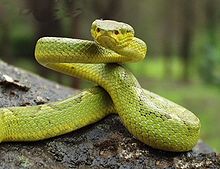Trimeresurus
| Trimeresurus | |
|---|---|
 |
|
| Bamboo pit viper, T. gramineus | |
| Scientific classification | |
| Kingdom: | Animalia |
| Phylum: | Chordata |
| Class: | Reptilia |
| Order: | Squamata |
| Suborder: | Serpentes |
| Family: | Viperidae |
| Subfamily: | Crotalinae |
| Genus: |
Trimeresurus Lacépède, 1804 |
| Synonyms | |
|
|
Trimeresurus is a genus of venomous pit vipers found in Asia from the Indian Subcontinent throughout Southeast Asia, China and the Pacific Islands. Currently 35 species are recognized. Common names include Asian palm pit vipers,Asian lanceheads and Asian lance-headed vipers.
Most species in the genus Trimeresurus are relatively small, primarily arboreal species, with thin bodies and prehensile tails. However, Trimeresurus flavoviridis (the Okinawa habu) can reach a total length (including tail) of 242 cm (7 ft 9 in), and is one of the longest pit vipers in East Asia. Most Trimeresurus species are typically green in color, but some species also have yellow, black, orange, red, or gold markings.
Their diet includes a variety of other animals, including lizards, amphibians, birds, rodents and other small mammals.
Like most viper species, many of the species in the genus Trimeresurus are ovoviviparous, bearing live young. However, some species such as T. flavoviridis, T. kaulbacki, and T. macrolepis are oviparous, lay eggs. Also, the reproductive biology of some Trimeresurus species is as yet unknown.
Their venom varies in toxicity between species, but all are primarily hemotoxic and considered to be medically significant to humans.
...
Wikipedia
